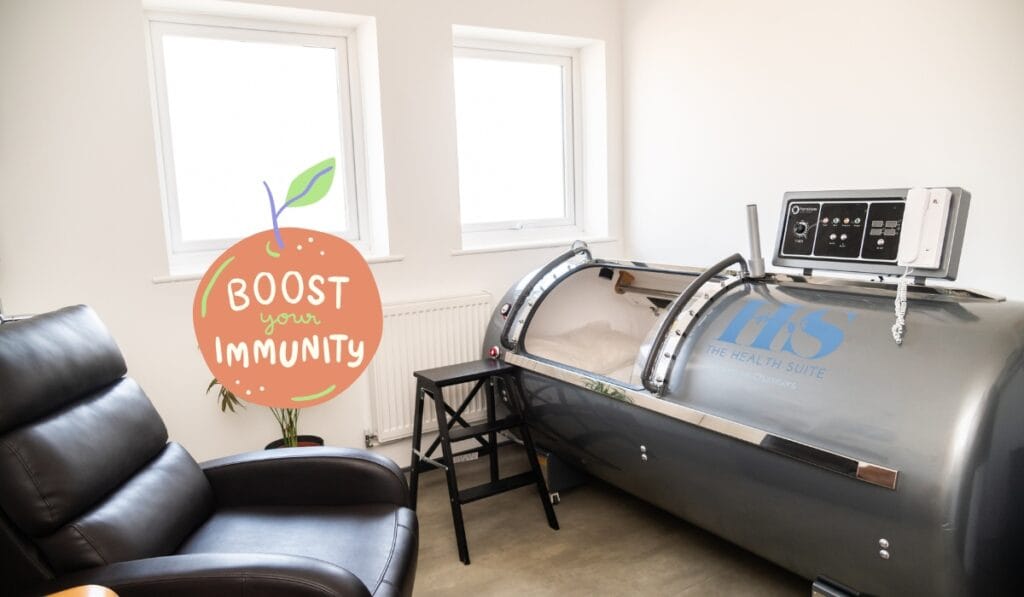What Is HBOT?
Hyperbaric Oxygen Therapy (HBOT) involves breathing 100% oxygen within a pressurised chamber, which enhances oxygen absorption into the bloodstream due to the increased pressure. Traditionally used for conditions like decompression sickness, HBOT is now gaining popularity for treating a variety of other conditions, including autoimmune conditions.
Understanding Autoimmune Disorders:
An autoimmune disorder happens when the immune system, which normally defends the body against infections and foreign invaders, mistakenly attacks the body’s own tissues and organs. This incorrect immune response can affect almost any part of the body, causing various symptoms based on the tissues involved. Common autoimmune disorders include Rheumatoid Arthritis (RA), Lupus, Multiple Sclerosis (MS), Type 1 Diabetes, and Inflammatory Bowel Disease (IBD).
The precise causes of autoimmune disorders remain unclear, but they are thought to arise from a mix of genetic, environmental, and possibly hormonal factors. Treatments typically aim to reduce inflammation and suppress immune system activity.
How HBOT Can Benefit People with Autoimmune Disorders:
HBOT has shown promise in managing autoimmune disorders through various mechanisms:
- Immune Modulation:
Overall Immune Effects: Studies suggest that HBOT can positively affect immune cell populations, potentially benefiting autoimmune diseases. - Symptom Suppression:
Long-term HBOT Exposure: Research indicates that prolonged HBOT can suppress symptoms such as proteinuria (excess protein in urine), facial erythema (redness), and lymphadenopathy (swollen lymph nodes). - Early Intervention:
Increased Survival Rates in Animal Models: Using HBOT in the early to mid-stages of autoimmune diseases in mice has been shown to increase survival rates, reduce inflammatory cells, lower anti-dsDNA antibody levels, and improve the condition of affected tissues. - Inflammation Reduction:
Anti-inflammatory Effects: HBOT reduces inflammation, which is a common feature of autoimmune disorders. This helps protect tissues from further damage. - Infection Control:
Enhanced Immune Response: HBOT helps fight infections by enhancing the immune system’s ability to combat pathogens. - Tissue Repair:
Enhanced Healing: HBOT promotes the repair of damaged tissues, aiding in recovery from autoimmune attacks.
HBOT and Specific Autoimmune Diseases
- Multiple Sclerosis (MS):
Mixed Results: HBOT has shown mixed results in human studies. Patients with less severe forms of MS have experienced favourable and lasting responses. Early-stage lesion development appears to benefit most from HBOT. - Inflammatory Bowel Disease (IBD):
Colonic Inflammation: HBOT reduces colonic inflammation by decreasing pro-inflammatory chemicals and improving antioxidant expression. A systematic review found it to be a safe and efficient treatment option for IBD patients. - Rheumatoid Arthritis (RA):
Inflammation Reduction: HBOT helps reduce inflammation by converting harmful cells into helpful ones, improving oxygen levels in the affected tissues. - Type 1 Diabetes:
Diabetic Foot Ulcers Studies show that HBOT reduces the activity of certain enzymes and proteins in white blood cells, which helps significantly heal diabetic foot ulcers. Read more about Diabetes and Hyperbaric Oxygen Therapy. - Lupus:
Animal Studies: Improved survival rates and reduced symptoms in animal models suggest potential benefits for lupus treatment. However, human data is limited. - Fibromyalgia:
Symptom Alleviation: HBOT improves oxygen supply, reduces inflammation, promotes nerve health, and optimises mitochondrial function, thereby alleviating fibromyalgia symptoms.
Is HBOT Safe for Autoimmune Disorders?
A large review of studies concluded that HBOT is generally safe and well-tolerated as a complementary therapy for autoimmune disorders, with very few serious side effects.
Conclusion
Hyperbaric Oxygen Therapy presents a promising complementary treatment for various autoimmune disorders. By improving oxygen delivery, reducing inflammation, and enhancing tissue repair, HBOT offers hope for better management of these challenging conditions. As research continues, HBOT may become a vital part of comprehensive autoimmune disease care, significantly improving patients’ quality of life.
Click here to learn more about Hyperbaric Oxygen Therapy and book an appointment.
References
- Bellato, E., Marini, E., Castoldi, F., Barbasetti, N., Mattei, L., Bonasia, D.E. & Blonna, D. 2012, “Fibromyalgia syndrome: etiology, pathogenesis, diagnosis, and treatment”, Pain research and treatment, vol. 2012, no. 1, pp. 426130.
- Brenner, I., Shephard, R.J. & Shek, P.N. 1999, “Immune function in hyperbaric environments, diving, and decompression.”, Undersea & hyperbaric medicine: journal of the Undersea and Hyperbaric Medical Society, Inc, vol. 26, no. 1, pp. 27-39.
- Chen, S., Chen, Y., Wang, J., Hsu, H., Ho, P., Chen, Y. & Sytwu, H. 2003b, “Early hyperbaric oxygen therapy attenuates disease severity in lupus-prone autoimmune (NZB× NZW) F1 mice”, Clinical Immunology, vol. 108, no. 2, pp. 103-110.
- Dulai, P.S., Gleeson, M.W., Taylor, D., Holubar, S.D., Buckey, J.C. & Siegel, C.A. 2014, “Systematic review: the safety and efficacy of hyperbaric oxygen therapy for inflammatory bowel disease”, Alimentary Pharmacology & Therapeutics, vol. 39, no. 11, pp. 1266-1275.
- Halder, S.K. & Milner, R. 2021, “Hypoxia in multiple sclerosis; is it the chicken or the egg?”, Brain, vol. 144, no. 2, pp. 402-410.
- Harnanik, T., Soeroso, J., Suryokusumo, M.G. & Juliandhy, T. 2020, “Effects of Hyperbaric Oxygen on T helper 17/regulatory T Polarization in Antigen and Collagen-induced Arthritis: Hypoxia-inducible Factor-1α as a Target”, Oman Medical Journal, vol. 35, no. 1, pp. e90.
- Londahl, M., Fagher, K., Nilson, A. & Katzman, P. 2018, “Hyperbaric Oxygen Therapy Is Associated with Improved Six-Year Survival in People with Chronic Diabetic Foot Ulcers”, Diabetes, vol. 67, no. Supplement_1.
- Novak, S., Drenjancevic, I., Vukovic, R., Kellermayer, Z., Cosic, A., Tolusic Levak, M., Balogh, P., Culo, F. & Mihalj, M. 2016, “Anti‐Inflammatory Effects of Hyperbaric Oxygenation during DSS‐Induced Colitis in BALB/c Mice Include Changes in Gene Expression of HIF-1α, Proinflammatory Cytokines, and Antioxidative Enzymes”, Mediators of inflammation, vol. 2016, no. 1, pp. 7141430.
- Ortega, M.A., Fraile-Martinez, O., García-Montero, C., Callejón-Peláez, E., Sáez, M.A., Álvarez-Mon, M.A., García-Honduvilla, N., Monserrat, J., Álvarez-Mon, M. & Bujan, J. 2021, “A general overview on the hyperbaric oxygen therapy: applications, mechanisms and translational opportunities”, Medicina, vol. 57, no. 9, pp. 864.
Hyperbaric Oxygen Therapy (HBOT) is a medical treatment that entails breathing pure oxygen in a specially pressurised chamber, which enhances oxygen delivery to tissues, facilitating healing and reducing inflammation.

